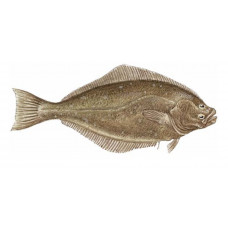Latin name
Hippoglossus hippoglossus
Other names
Common halibut, giant halibut, right-eyed flounder, chicken halibut (under 20 pounds); Dutch: heilbot; Finnish: ruijanpallas; French: flétan de l’Atlantique; Icelandic: heilagfiski; Japanese: ohyô; Norwegian: kveite; Portuguese: alabote; Spanish: fletán del Atlántico, hipogloso; Swedish: hälleflundra, helgeflundra.
Identification
The body is elongated broad, somewhat flattened, oval, bordered by long dorsal and anal fins. Head of moderate size. The mouth of this fish is massive. Both jaws are symmetrical. Teeth are well-developed on both jaws on both the ocular and blind sides of the head. The upper eye is located in the upper half of the head and does not reach its upper profile. The eyes are widely spaced and not covered with scales from above, the skin processes are also absent. The lateral line is well-developed on both sides of the body, it forms an arc above the pectoral fin, has about 160 scales, strongly curved above the pectoral fin. The dorsal fin begins on the upper profile of the head above the middle of the upper eye or slightly in front of it, and has 98 to 106 rays, and the anal fin has 73 to 80 rays. The body is covered on both sides with fine cycloidal scales, and there are additional fine scales. The coloration of the ocular side of the body is dark brown to grayish-brown or greenish-brown with white spots; the blind side is white.
Distribution
The Atlantic halibut lives in the waters of the North Atlantic. In North America, its range extends from Labrador to Virginia. This species does not occur in nearly ice-free polar waters, where it is replaced by Greenland halibut (Reinhardtius hippoglossoides).
Habitat
Sea bottom-dwelling, relatively heat-loving fish. Occurs depending on age and season, from coastal shallows to deep waters. Rarely enters water shallower than 200 feet and is usually found in depths of up to 3,000 feet. Occurs in cold (40° to 50 °F) water on sand, gravel, or clay bottoms.
Size
Halibut have been reported weighing between 300 and 700 pounds, with a rod and reel record of 355 pounds. The white-skinned halibut is the largest of the flounders. In the Atlantic, it has been known to catch an individual 4,700 cm long and weighing 337 kg. The largest known individual has been caught in the Bering Sea - it is 2440 cm long and weighs 227 kg and is 33 years old.
Life history and Behavior
Spawning occurs from late winter through early spring in deep water. The eastern Atlantic fish spawn from March through May. A female can release up to 2 million eggs, and the fish move shallower after spawning.
Food and feeding habits
The Atlantic halibut is a voracious feeder that stalks its prey in open water. It feeds mainly on fish, including cod and its relatives - ocean perch, herring, rays, mackerel, and other flounders. It also eats crabs, mussels, lobsters, and clams. Eats crustaceans, worms, clams, and echinoderms. In the Pacific Ocean, it feeds on navaga, pollock, salmon, charcoal fish, sea bass, flounder, herring, sand lance, crabs, octopus, and bivalves. Juveniles feed mainly on invertebrates, while those over 80 cm in length feed exclusively on fish.
Reproduction
In the Northeast Atlantic, there are halibut spawning grounds off the northwest coast of Norway, near Norland and Tromso, in the fjords and in the open sea near the coast. Spawning is protracted, occurs in the winter-spring period from late December to May at depths of more than 300 m at a temperature of at least 5-7 °C. Around northern Norway spawning takes place from late December to April, around Iceland - in February-April. The depth at the spawning grounds in Norway is from 300 to 700 m, in Iceland - up to 1000 m. Off the coast of Norway, the eggs hatch over soft substrates at a water temperature of not less than 6-7 °C. In the Pacific Ocean, mature fish concentrate on spawning banks along the continental slope from November to March at depths of 180-450 m. Spawning may continue throughout the year. Females weighing up to 20 kg may hatch about 500,000 eggs, those weighing over 100 kg - 4 million eggs or more. Eggs are large, 3.0-4.3 mm in diameter. Development at a water temperature of 6 °C lasts for 16 days. The hatching pre-larvae are 6.5-7.8 mm long. At a length of 32-40 mm, the fry switch to the bottom lifestyle.
| Classification | |
| Phylum | Chordata |
| Class | Actinopterygii |
| Squad | Pleuronectiformes |
| Family | Pleuronectidae |
| Genus | Hippoglossus |
| Species | H. hippoglossus |
| Features | |
| Conservation status | Vulnerable |
| Habitat | bottom |
| Life span, years | 50 |
| Maximum body weight, kg | 320 |
| Maximum length, cm | 470 |
| Sailing speed, m/s | No information |
| Threat to people | Edible |
| Way of eating | predator |





